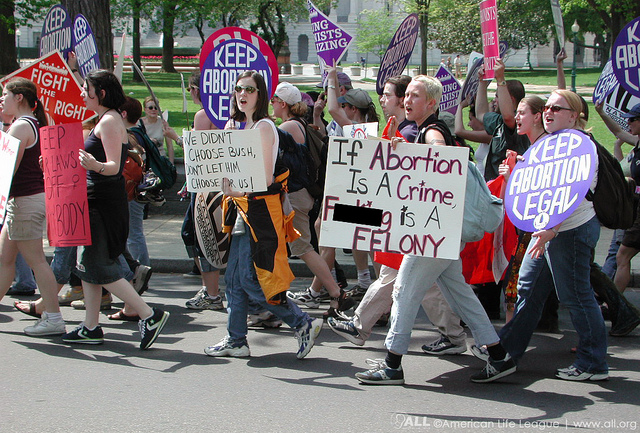In U.S., abortion debate predates Roe by decades
By

In U.S., abortion debate predates Roe by decades
By
This episode of Worldview was originally broadcast on August 12, 2011.
Friday we conclude our Here, There series on abortion with a look at the debate in the United States.
Earlier in the week, we learned that abortion in France is framed in medical, rather than moral and political terms, that laws in Mexico vary by state and that Portuguese women often struggle to find doctors to perform the procedure.
Though certain parallels can be drawn between our debate and those in other countries, U.S. abortion politics stand out as particularly divisive. The extremes on both sides dominate the cultural conversation. Politicians, activists and the media rarely attempt to find a middle ground.
To make sense of how we got here, we talk to Melody Rose, author of Safe, Legal and Unavailable? Abortion Politics in the United States and founder and director of the Center for Women, Politics and Policy at Portland State University. Rose takes us through the long and winding path of U.S. abortion, starting at least a century before Roe v. Wade.
On the abortion debate’s starting point in America:
“[In the mid-19th century] doctors led the charge for restricting access to abortions in part to take away the clients of their midwife competitors — who normally handled abortions… Many women in abortion practices were not very safe, so doctors also made a safety claim.”
On pro-life activism:
“Most of the pro-life activism in the U.S. in the 20th century was driven by social conservatives from protestant ranks. We can certainly look to the Catholic Church around its policies, which became stricter in the 1960s, but most of the social movement organizations in this country that formed in prior to and in response to Roe vs. Wade… were Protestant based.”
Before Roe v. Wade:
“[The 1873 Comstock Act] essentially equated any form of reproductive health advertising with obscenity and made it illegal to pass any of that material through U.S. mail. Most women received a lot of their information about reproductive health decisions and fertility options through the old fashioned women’s magazines. Comstock was very effective in limiting ads for abortion, which cut off a lot of access for women.”
“Abortion became inaccessible for women in this country. For some periods of that time we had rising birth rates, more self-aborting and access to illegal procedures, which was leaving a lot of women dead and physically damaged. These trends in the mid-20th century lead us to the women’s movement in the 1960s.”
Leading up to Roe v. Wade:
“Doctors begin to agitate on behalf of liberalizing access to abortion because they frequently saw women desperately seeking ways to control their fertility in ways that wouldn’t leave them badly, physically wounded. So doctors began the movement to policy change in the 1960s and the women’s organizations followed suit.”
“By 1973 when Roe v. Wade was handed down by the Supreme Court, there had been an entire decade or two of activism from doctors and women’s liberal organizations.”
On the landmark Roe v. Wade decision:
“In 1973, Justice Blackman spent some time researching abortion practices across the world and cultures when deciding this case. He found that people were most uncomfortable with ending a pregnancy past twelve weeks.”
“Blackman created the ‘trimester system.’ The ruling set up a system that gave women the greatest right in the first trimester. Following that, the state’s interest in the ‘future citizen’ grows as the emerging fetus grows.”
Important points following Roe v. Wade:
“The Webster v. Reproductive Services ruling opened the doors to more pro-life policy. This case claimed that if a fetus has rights at the end of pregnancy, then it certainly does at the beginning. It gave a lot of hope to pro-life activism.”
“The 1992 case of Planned Parenthood v. Casey created the concept that states have the ability to restrict abortion so long as that restriction does not create an ‘undue burden to the woman.’ And since then, we have been debating what an ‘undue burden to a woman’ really means.”
On what we face today:
“It’s critical to know this trend: The vast majority — about 90 percent — of counties in this nation have no abortion provider.”
“Abortions are going down in the U.S. A lot of it has to do with contraceptive policy which is pretty liberal and the U.S. has been successful in controlling unintended pregnancy, which has reduced the demand for abortion.”